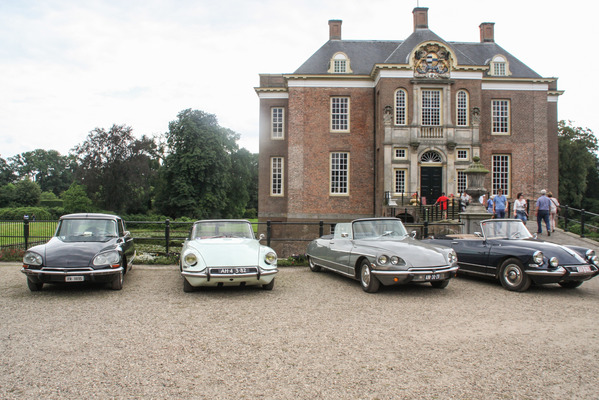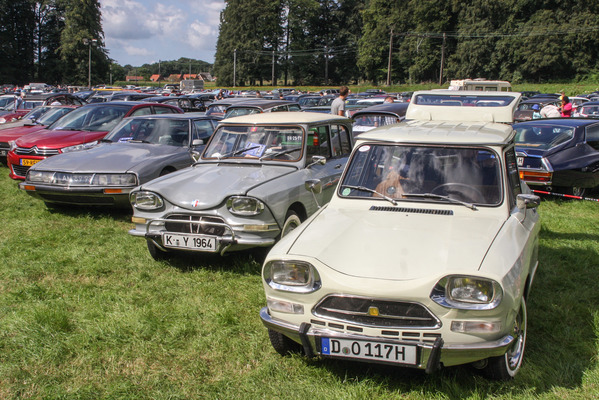The sight of historic vehicles at his castle is nothing unusual for Franz Graf zu Ortenburg. The German aristocrat is lord of the castle 'Kasteel Middachten' in De Steeg near Arnhem, which has been in his family for over 800 years. Count Ortenburg himself is a passionate classic car fan: as Vice President of the time-honored Automobile Club of Germany, he is responsible for classics and finances, enjoys competing in historic events and races himself and has headed the International Commission for Historic Vehicles of the FIA (Fédération Internationale de l'Automobile) since the end of last year. However, 5,000 more or less historic Citroëns in the castle park was also a very special event for Count Ortenburg from August 11 to 14, 2016.

Fascinating parallel
"This shows the connection between our efforts to maintain our eight-century-old country estate and the efforts of Citroën owners to maintain their vehicles as an automotive cultural asset. A fascinating parallel," said Count Ortenburg. The medieval Middachten Castle with its beautiful grounds proved to be an excellent location for the event, with the majority of participants spending the night on the outstretched grass. "It was certainly the most international event we've ever had here," says Count Ortenburg. "It was fascinating for me to see how big the global Citroën family is. I also think it's nice that the company itself is also looking after the brand's past."
In the Netherlands for the third time
For the third time in its history, which dates back to 1972, the Citroën World Meeting took place in the Netherlands, after 1981 in Breda and 1988 in the 'De Flevohof' theme park in Biddinghuizen, which is even below sea level. The enthusiasm for the Citroën brand is perhaps even greater in the Netherlands than in its home country of France. "If you look at the number of Citroën clubs in relation to the number of inhabitants, it's actually true," confirms Xavier Crespin, who recently became responsible for historical matters relating to the Citroën, DS and Peugeot brands at the PSA Group. "In the 1980s in particular, many old Citroëns that nobody in France wanted any more went to the Netherlands and were restored. Even so-called 'youngtimers' such as the Visa or BX, or previously the CX, were considered collectible in the Netherlands at a much earlier stage than in France, which was also accompanied by the founding of corresponding clubs."
Second home
The descendants of company founder André Citroën regard the Netherlands as their second home, as grandson Henri-Jacques Citroën emphasized in his welcoming address to the participants at the Citroën World Meeting. No wonder, since André Citroën's ancestors came from Amsterdam. "As André Citroën's grandson, I am always impressed by these large international meetings, which prove that the participants belong to a special party, the Citroën party. Not a political party, of course, but a friendly association of enthusiastic collectors who appreciate the outstanding design and special technologies that have been developed since 1919, and who admire the life and achievements of André Citroën," explained the Frenchman, who, contrary to previous announcements, was not present at the world meeting himself.
Not just on the Internet, but live
Instead, as already mentioned, numerous other participants were on site. Some had traveled a long way: Australians, New Zealanders, Citroën drivers from California, South America, Asia... One Greek man did not shy away from the almost 3,000-kilometer drive in his 30-year-old Citroën Visa. "Without air conditioning, of course, but all the windows can be opened," he grinned. The many German participants had a shorter journey, as Middachten Castle is located just a few kilometers from the Dutch-German border. "This is my first time taking part and I'm really excited," said Axel Flohr, who was born in Cologne but now lives in Teltow near Berlin. Five years ago, he fulfilled a dream by buying a beautiful Citroën SM: "After 20 years of DS, it was time for a change." Flohr sold beautiful Citroën model cars at the so-called 'car trunk sale', where all participants can offer goods free of charge, which he makes many collectors happy with. "What I find so great here is that you meet a lot of people you otherwise only know from the internet," he emphasized. "And they all share the same passion for the brand. For me, it started as a child: My father drove a DS, that was formative."
From Yugoslavia to the USA
In his welcoming address, Henri-Jacques Citroën described the Citroën World Rally, which officially bears the somewhat unwieldy name 'International Citroën Car Club Rally', as a 'large, living open-air museum'. It began in 1972 as an initiative of a few 2CV owners in Porec in what was then Yugoslavia. Two years later, the Citroën fan community met in Vienna, two years later again in Kenilworth in the UK, but the worldwide enthusiasm for the event really took off with the meeting in Chartres in France in 1978. In 2002, there was even a world meeting in the United States, but because this meant a very long journey for many Europeans, the next event followed just two years later in the Swiss town of Interlaken. Otherwise, the four-year cycle for the 'ICCCR' has become established.

Important figurehead
"The ICCCR is an important showcase for us," emphasized Stephan Joest, Chairman of 'Amicale Citroën Internationale'. The worldwide umbrella organization of Citroën clubs represents over 1,000 clubs from 37 nations, uniting more than 67,000 members. "The latest additions are Thailand, Iran and South America," says the man from Düsseldorf, who himself drives an Ami 6, among others. "You shouldn't underestimate the scale of an event like this: 250 to 300 volunteers and a mid-six-figure budget to pull it all off. And you have to bear in mind that a world meeting like this is usually a one-off event for the organizers. You have exactly one chance to get it right. And once again, we succeeded perfectly!" It only rained cats and dogs on the first day, but on the following three days, glorious summer weather contributed to the success of the event.
Cross-section
What the participants and visitors were able to see was a cross-section of the Citroën brand's almost one hundred-year history, from pre-war rear-wheel drive models to legendary Citroën models such as the Traction Avant, DS and 2CV and more recent model series such as the CX, BX and Visa.
Special exhibitions paid tribute to specific aspects of the brand's history, such as Citroën trucks and commercial vehicles as well as ambulances. A special presentation focused on the Citroën-based creations of French coachbuilder Henri Chapron. Today, his daughter Noëlle Chapron-Paul looks after her father's automotive legacy and advises owners of the special coupés, saloons and convertibles, many of which were designed on a DS basis. In recent years, prices for DS convertibles have risen spectacularly. "There are many suppliers today who make convertibles based on DS and want to sell them as originals, but only the cars that were created in my father's atelier are the real convertibles," emphasized the Frenchwoman, who was also present at the World Meeting.
Next time in Poland
The Kégresse, special Citroën tracked vehicles that were used for spectacular expeditions in the Sahara and the Gobi Desert in the 1920s, also caused quite a stir. Such activities were not only supported by André Citroën, but also accompanied by the media on a grand scale, as the industrial pioneer immediately understood the advertising value for his company.
Some Danish participants, who had traveled from their home country to the Netherlands with their lovingly restored Kégresse, were rewarded for their efforts with the prize at the 'Concours d'Elégance'. The next Citroën World Meeting will take place in 2020, then in Torún, Poland. Many enthusiasts are already counting down the days until then...















































































































































